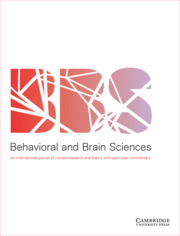Crossref Citations
This article has been cited by the following publications. This list is generated based on data provided by Crossref.
Mealey, Linda
1997.
An Evolutionary, But Not Stable Strategy for Crime Control.
Politics and the Life Sciences,
Vol. 16,
Issue. 1,
p.
38.
Belsky, Jay
1997.
Variation in Susceptibility to Environmental Influence: An Evolutionary Argument.
Psychological Inquiry,
Vol. 8,
Issue. 3,
p.
182.
Brewis, Alexandra A.
and
Pi�eda, David
2001.
Population variation in children's behavioral symptomatology.
American Journal of Physical Anthropology,
Vol. 114,
Issue. 1,
p.
54.
Mealey, Linda
2001.
Conceptual Challenges in Evolutionary Psychology.
Vol. 27,
Issue. ,
p.
19.
Skeem, Jennifer L
Poythress, Norman
Edens, John F
Lilienfeld, Scott O
and
Cale, Ellison M
2003.
Psychopathic personality or personalities? Exploring potential variants of psychopathy and their implications for risk assessment.
Aggression and Violent Behavior,
Vol. 8,
Issue. 5,
p.
513.
Mealey, Linda
2003.
The Biodemography of Human Reproduction and Fertility.
p.
1.
Ross, Scott R.
Benning, Stephen D.
Patrick, Christopher J.
Thompson, Angela
and
Thurston, Amanda
2009.
Factors of the Psychopathic Personality Inventory.
Assessment,
Vol. 16,
Issue. 1,
p.
71.
Gillespie, Steven M.
Mitchell, Ian J.
Johnson, Ian
Dawson, Ellen
Beech, Anthony R.
and
Szolnoki, Attila
2013.
Exaggerated Intergroup Bias in Economical Decision Making Games: Differential Effects of Primary and Secondary Psychopathic Traits.
PLoS ONE,
Vol. 8,
Issue. 8,
p.
e69565.
Salihovic, Selma
Kerr, Margaret
and
Stattin, Håkan
2014.
Under the surface of adolescent psychopathic traits: High‐anxious and low‐anxious subgroups in a community sample of youths.
Journal of Adolescence,
Vol. 37,
Issue. 5,
p.
681.
Blanchard, Alyson
Lyons, Minna
and
Centifanti, Luna
2016.
An effective way to deal with predators is to taste terrible: Primary and secondary psychopathy and mate preference.
Personality and Individual Differences,
Vol. 92,
Issue. ,
p.
128.
DeLisi, Matt
2016.
Psychopathy as Unified Theory of Crime.
p.
15.
Blanchard, Alyson
Lyons, Minna
and
Centifanti, Luna
2016.
Baby was a black sheep: Digit ratio (2D:4D), maternal bonding and primary and secondary psychopathy.
Personality and Individual Differences,
Vol. 99,
Issue. ,
p.
67.
Sewall, Lindsay A.
and
Olver, Mark E.
2018.
Sexual offender treatment outcomes among psychopathy subtypes.
Journal of Criminological Research, Policy and Practice,
Vol. 4,
Issue. 3,
p.
161.
Davis, Adam C.
Visser, Beth A.
Volk, Anthony A.
Vaillancourt, Tracy
and
Arnocky, Steven
2019.
The Relations between Life History Strategy and Dark Personality Traits among Young Adults.
Evolutionary Psychological Science,
Vol. 5,
Issue. 2,
p.
166.
Skowroński, Bartłomiej
2019.
Typologie wadliwej integracji postaw w świetle teorii wykolejenia społecznego Czesława Czapówa. Studium teoretyczno-empiryczne.
Mokros, Andreas
Hare, Robert D.
Neumann, Craig S.
and
Habermeyer, Elmar
2020.
The Wiley International Handbook on Psychopathic Disorders and the Law.
p.
107.
Adshead, Gwen
and
McGauley, Gill
2020.
The Wiley International Handbook on Psychopathic Disorders and the Law.
p.
835.
Taylor, Sandie
and
Workman, Lance
2020.
The Cambridge Handbook of Evolutionary Perspectives on Human Behavior.
p.
471.
Mokros, Andreas
Hollerbach, Pia S.
and
Eher, Reinhard
2021.
Offender Subtypes Based on Psychopathic Traits.
European Journal of Psychological Assessment,
Vol. 37,
Issue. 1,
p.
33.
Gillespie, Steven M.
Garofalo, Carlo
and
Centifanti, Luna C.M.
2021.
Variants of psychopathy in male and female civil psychiatric patients: Latent profile analyses of the MacArthur violence risk dataset.
Journal of Criminal Justice,
Vol. 72,
Issue. ,
p.
101748.


